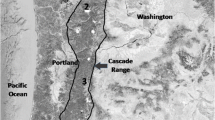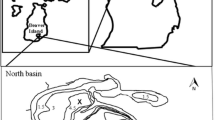Abstract
Surficial sediments (0 to 12 cm) were removed from three lakes located within 20 km of a large siderite sintering plant which annually releases 140 000 tonne S and sinter fly ash up its stacks. A fourth lake located approximately 100 km upwind of the sintering plant was chosen as a control. Lake sediments were analyzed for sulphate, pyrite, organic S, total S and subfossil diatoms.
The rate of lake acidification inferred from stratigraphic changes in diatom species composition indicated that one of the lakes located in a granitic basin near the sintering plant was undergoing rapid acidification. The other two study lakes located near the sintering plant were situated on carbonate-rich greenstones. Their pH as inferred from diatom stratigraphy indicated that both lakes were actually increasing in pH over the last 30 yr. The diatom inferred pH of the control lake's deeper sediments (4.8 ± 0.2) did not differ significantly from the lakes' present day observed pH (4.9).
Lakes closest to the sintering plant had the highest S concentrations in their sediments. In addition, their surface sediments (0 to 2 cm) had significantly higher pyrite concentrations than their deeper sediments. Organic S and pyrite S comprised the major fraction of S in the sediments of all four lakes.
The S isotope ratios (δ34S) in the various forms of S in the lake sediments were also measured. The δ34S values in the deeper (10 to 12 cm) sediments were found to be fairly uniform in all four lakes at + 4.0%., almost identical to those of the lake sulphates upwind from the Wawa sintering plant. This suggests little or no S isotope fractionation during sulphate reduction and precipitation of sulphides at the time of sediment deposition roughly 100 yr age.
However, δ34S values in the surface sediments (0 to 2 cm) were shifted toward negative values. In the lakes downwind from the Wawa smelter, the isotope shift ranged from 14 to 16%, whereas in the upwind lakes the shift was very much smaller ranging from 1.5 to 5.0%. This shift in δ34S in the recent sediments wass presumed to be largely a result of isotope fractionation in the dissimilatory reduction of lake sulphate by bacteria stimulated by anthropogenic inputs of S.
The possibility of anthropogenic inputs of S with high negative δ34S values to explain the shifts in isotopic ratios seems unlikely in view of known δ34S values for the ores in the area. Additional δ34S measurements on lake sediments, lake sulphates and ore samples (smelter effluent), etc., have been undertaken. This should make it possible to interpret the 534 shift in the sediments in terms of environmental changes since the Ambrosia rise (circa 1890).
Similar content being viewed by others
References
Battarbee, R. W.: 1973, Limnol. Oceanog. 18, 647.
Berg, F.: 1979, ‘Diatoms and pH in some Lakes in the Agder and Hordaland Counties, Norway’, SNSF Prostektet IR 42/79, 66 pp.
Cleve-Euler, A.: 1951–55, Die diatomeen von Schweden and Finnland, Kunglia Svenska Velenskapsakademien Avhandlingar, Almqvist and Wiksells, Stockholm 5, 2(1); 3(3); 4(1)1, 4(5); 5(4).
Cook, R. B. and Schindler, D.: 1983, ‘The Biogeochemistry of Sulfur in an Experimentally Acidified Lake’, Environmental Geochemistry. Ecol. Bull. (Stockholm) 35, 115–127.
DeLaune, R. D., Patrick, W. H. Jr., and Buresh, R. J.: 1978, Nature 275, 525.
Edgington, D. N. and Robbins, J. A.: 1976, ‘Patterns of Deposition of Natural and Fallout Radionuclides in the Sediments of Lake Michigan and their Relation to Limnological Processes’, in Nriagu, J. O. (ed.), Environmental Biogeochemistry, Vol. 2, Metal Transfer and Ecological Mass Balance: Ann Arbor Science, pp. 705–729.
Dickman, M., Dixit, S., Fortescue, J., Terasmae, J., and Barlow, R.: 1984, Water, Air and Soil Pollut. 21, 375.
Fisher, J. B., Lick, W. J., McCall, P. L., and Robbins, J. A.: 1980, J. Geophys. Res. 85, 3997.
Foged, N.: 1979, Diatoms in New Zealand, the North Island, Struss and Cramer Publ., Hirschberg, Germany, 225 pp.
Fortescue, J. A. C., Thompson, L, Dickman, M., and Terasmae, J.: 1981, Multidisciplinary Follow-up of Regional pH Patterns in Lakes North of Lake Superior, District of Algoma (Part 2 — Data listings), Ontario Geological Survey Open file report 5342, 410 pp.
Fortescue, J. A. C., Dickman, M., and Terasmae, J.: 1984, Multidisciplinary Follow-up of Regional pH Patterns in Lakes North of Lake Superior, Ontario Geological Survey Open file report 5483, ca. 500 pp.
Gerloff, J. and Cholnoky, B. J.: 1970, Diatomaceae II, Verlag Von J. Cramer, Hirschberg, Germany, 835 pp.
Germain, H.: 1981, Flore des diatomées, Societé Nouvelle des Editions Boubée, Paris, 444 pp.
Goodwin, A. M., Monster, J., and Thode, H. G.: 1976, Econ. Geol. 71, 870.
Harrison, A. G. and Thode, H. G.: 1958, Trans. Faraday Soc. 54, 84.
Huber-Pestalozzi, J.: 1942, Das Phytoplankton des Susswassers, Unveranderter Nachdruck, Stuttgart, 549 pp.
Hustedt, F.: 1930, ‘Bacillariophyta (Diatomea)’, in Pascher, A. (ed.), Die Susswasser Flora Mitteleuropas, Jeana 10, 446 pp.
Kilham, P.: 1982, Limnol. Oceanog. 27, 858.
Monster, J.: 1978, Sediment analysis, Internal Laboratory Report, McMaster University.
Nriagu, J. O. and Coker, R. D.: 1978, Nature 274, 883.
Nriagu, J. O., Wong, H. K. T., and Coker, R. D.: 1982, Environ. Sci. Technol. 16, 551.
Oliphant, W. L.: 1982, Personal communication, Director, Lands and Forests Division, Algoma Central Railway.
Patrick, R. and Reimer, C. W.: 1975, The Diatoms of the United States, Vol. 1, The Academy of Natural Sciences of Philadelphia 13, 688 pp. Patrick R. and Reimer, C. W.: 1975, The Diatoms of the United States, Vol. 2, The Academy of Natural Sciences of Philadelphia 18, 213 pp.
Pennington, W., Cambray, R. S., and Fisher, E. H.: 1973, Nature 242, 324.
Stewart, D.: 1982, Personal communication, Manager, Environmental Control Division, Algoma Steel Corp., Sault Ste. Marie, Ontario P6A 5T2.
Sumi, C. K.: 1982, Maps of the Cutting History for Selected Areas in the Algoma District near Wawa, Ontario, Ministry of Natural Resources, P.O. Box 1160, Wawa, Ontario POS 1KO.
Thode, H. G., Monster, J., and Dunford, H. B.: 1961, Geochim. Cosmochim. Acta 25, 159.
Thode, H. G.: 1980, Origins of Life 10, 127–136.
Weizman, B.: 1980, Long Range Transport of Sulphur from Algoma Ore Operations, Report prepared for Algoma Ore Div. by Meteorological and Environmental Planning Ltd., 850 Magnetic Drive, Downsview, Ontario.
Author information
Authors and Affiliations
Rights and permissions
About this article
Cite this article
Dickman, M.D., Thode, H.G. The rate of lake acidification in four lakes North of lake superior and its relationship to downcore sulphur isotope ratios. Water Air Soil Pollut 26, 233–253 (1985). https://doi.org/10.1007/BF00294134
Received:
Revised:
Issue Date:
DOI: https://doi.org/10.1007/BF00294134




